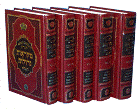 Perhaps the best-known segulah for finding one’s shidduch is davening at Amukah, the burial place of Reb Yonason ben Uziel, the Tanna and author of Targum Yonasan ben Uziel. With the publication of the 5th volume, on Chumash Bamidbar a major achievement has been introduced. Never before in history has a project of this magnitude and caliber on this work been attempted, namely to interpret the intricate, hidden secrets and mystical messages expressed in the words of Targum Yonasan.
Perhaps the best-known segulah for finding one’s shidduch is davening at Amukah, the burial place of Reb Yonason ben Uziel, the Tanna and author of Targum Yonasan ben Uziel. With the publication of the 5th volume, on Chumash Bamidbar a major achievement has been introduced. Never before in history has a project of this magnitude and caliber on this work been attempted, namely to interpret the intricate, hidden secrets and mystical messages expressed in the words of Targum Yonasan.
Firstly, the author of the compendium, Rabbi Henoch Levine labored, for laymen and scholars alike, to have the opportunity to understand the Aramaic words of the Tanna Yonason ben Uziel. Rabbi Levine created an easy to understand word-for-word Hebrew translation, alongside seemingly difficult Targum Aramaic passages.
Moreover, Rabbi Levine presents an analysis of the chiddushim (new insights) therein, by tapping into the resources and clarifications of all the major Rishonim, to determine what prompted Rabbi Yonasan to arrive at his conclusion. The author does not stop there, but cites relevant explanations expounded by the early and later Acharonim. The sources are cited verbatim, so as to retain their true flavor and intent, which are often lost in translation and interpretation.
But Sarasi BaMedinos is much more than a sefer ha’likuttim, a simple collection. It is written and designed to challenge the reader’s intellect by posing questions on the parshah not usually found anywhere else. The rich and concise subject matter easily evokes lively discussions and conversations around the Shabbos table, where young and old will be drawn in.
By means of the questions and insights, differences of opinions between Rashi, Ramban and Targum Yonasan surface, which bring new clarity on the underlying subject matter. The reader will find every page bursting with inspirational lessons teaching proper hashkafah, mussar and middos tovos.
Perhaps an even greater accomplishment attained in the Sarasi BaMedinos series is the blending of differing traditional schools of thought, such as the lomdishe camp expounded by the great Roshei Yeshiva and Rabbanim of yesteryear and today, and the Chassidishe camp, carried forward by Chassidishe Rebbes of old, as well as those of today. Both of these approaches are shown in many cases to be intertwined, complementing each other’s intense perspective.
The reader, with the aid of the Sarasi BaMedinos series, will derive much gratification when being Ma’avir Sidrah – Shnayim Mikra V’Echad Targum. The Targum is newly reset in an attractive format and sources are highlighted in bold for easy identification. A Tanach and Shas index as well as a complete listing of all the sefarim quoted, their authors, with date and origin of first printing, is included.
In the latest Bamidbar volume, a comprehensive index of every topic expounded in all volumes is included. The acquisition of one volume, or the entire set, will give the zechus of owning Torah teachings from more than 300 different sefarim quoted verbatim, a virtual instant library not ordinarily accessible. To secure a set or volume, visit your nearest quality Judaica store, or order directly from the author at 347-249- 8415.
{Rabbi G. Tannenbaum-Machberes/Matzav.com Newscenter}












This sounds like a fantastic sefer.
The overwhelming consensus amongst academic scholars is that Targum Yonasson al HaTorah, unlike the Tragum Yonasson al Tanach, dates from medieval times, not from the time of the Tanna Yonnasson ben Uziel.
It is thought that its real name is Targum Yerushalayim and that the TY abbreviation was mistakenly changed to Targum Yonasson by a printer.
http://en.wikipedia.org/wiki/Targum_Pseudo-Jonathan
I was wondering whether the author of this sefer deals with this issue. Does he belive, like the reviewer here, that this work was, in fact, written in Tannaitic times?
“Perhaps the best-known segulah for finding ones shidduch is davening at Amukah, the burial place of Reb Yonason ben Uziel, the Tanna and author of Targum Yonasan ben Uziel.”
Is that Yonason ben Uziel’s main claim to fame nowadays? Oy vey! What does that have to do with the great Torah involved? Why cheapen his Torah by mixing this in?
I would like to know when the legend of prayer at amuka=shidduch started. I understand that a big boki researched it and found that it was a relatively recent thing. If anyone knows the first time such a claim was made, please post it.
Response to #2:
Read my comment, above.
The Amuka / Shidduchim / Rabbi Yonasson ben Uziel association is a very recent development, supposedly invented by an imaginative tour guide.
It’s one more thing that Rabbi Yonnasson will be remembered for that he had nothing to do with.
shlomo – that article has no mekoros. Do you think we care about what academics think? They’re the same ones who said the torah was written by ezra cv’s, and a list of other baseless nonsense- their tactic is to always assign the latest date possible to anything. Honestly, read Rav Avigdor Miller’s ‘awake my glory’ for a nice sampling of how academics have no ideas what they’re talking about.
Any poskim talk about this? Where do you get the idea of ‘targum yerushalmi’ anyway?
Or is it just from moreinu verabbeinu wikpedia?
Well, if you don’t trust the academics, how about trusting the gemara?
The gemara says only that he wrote a peirush on novi.
How about trusting our own Rabbonim HaKadmonim, who never mention a targum on the Torah written by Rav Yonnason?
You prefer to trust instead the aino yehudi who printed the medieval edition of Mikraos Gedolos where this Targum appears as Targum Yonasson for the first time in history?
For another popular summary, see this:
http://www.absoluteastronomy.com/topics/Targum_Pseudo-Jonathan#encyclopedia
BTW, all I was doing was asking whether the author of this sefer deals with this issue.
For all I know, the author agrees that it was written 900 years later than Rav Yonasson.